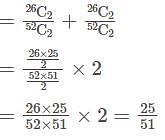Mock Test - 1 (EDU) - Software Development MCQ
30 Questions MCQ Test - Mock Test - 1 (EDU)
Everybody in a room shakehands with everybody else. The total number of hand shakes is 66. The total number of persons in the room is:
Five students participated in a race. Akbar finished the race ahead of Manish but behind Ganesh. Ragul finished the race ahead of Sanjay but behind Manish. Who won the race?
| 1 Crore+ students have signed up on EduRev. Have you? Download the App |
Direction: What will come in place of the question mark (?) in the following number series?55, 20, 50, 25, 45, ?
In a certain code FIRE is coded as DGPC. What will be the last letter of the coded word for SHOT.
The 5th and 13th terms of an AP are 5 and - 3 respectively. Find the 16th term of the same AP?
A got 18% marks in an exam and failed by 36 marks. B got 26% marks in an exam and passed by 28 marks more than the passing marks. How many marks are needed to pass the exam?
Kunal buys two cars for Rs. 600. He sells one of them at a profit of 22% and the other at a loss of 8% and makes no profit or loss in the end. What is the selling price of the car that he sold at a profit?
Average weight of A, B and C is 45 kg. If average weight of A and B is 35 kg and that of B and C is 48 kg. The weight of A is?
∠A, ∠B and ∠C are three angles of a triangle, and ∠A ∶ ∠B ∶ ∠C = 1 ∶ 3 ∶ 2, then the sum of the largest and the smallest angle of the triangle is:
If the sum of the radius and the height of a closed cylinder is 35cm and the total surface area of the cylinder is 1540cm2 then the circumference of the base of the cylinder is:
Vaishnav left from place A at 11 a.m, for place B, and Suman left from place B at 2 p.m. for place A. The distance between them is 516 km. If Vaishnav’s speed is 44 km/h and Suman’s speed is 52 km/h, then at what time will they meet each other?
If 2 cards are drawn from a well shuffled pack of 52 cards, the probability that they are of the same colour is:
If the 5th day of a month is Wednesday, which of the following would be the 2nd day after the 20th day of that month?
The denominator of a rational number is 3 more than its numerator. If the numerator is increased by 7 and the denominator is decreased by 2, we obtain 2. The rational number is:
Direction: Following questions are based on five words given below.JMEV WBFJ SKIC DNPO HQTU(The new words formed after performing the mentioned operations may or may not necessarily be meaningful English words)If all the consonants of the words are replaced by their successors as per the English alphabetical series then how many words will have more than one vowel?
The sum of two numbers is 72. If the numbers are in the ratio 3 ∶ 5, then find the positive difference between the two numbers.
The LCM of two numbers is 14 times their HCF. The sum of LCM and HCF is 600. If one number is 280, then the other is:
A and B together can do a piece of work in a certain number of days. If A takes 9 more days and B takes 16 more days to finish the same work than A and B together. Then in how many days A alone can finish the work.
What will come in place of question mark ‘?’ in the following question?7.5% of 600 + 11.6 = 72 + (0.4 × ?)
Which of the following tissue develops from the ectoderm of the embryo?
Which organ is the first to form in the developing human fetus, formed after just 1 month of pregnancy?
Which of the following signal molecule is NOT used for extracellular signaling?
Which of these is not an associated function of the increased maternal hormones estrogen, progesterone, prolactin, and cortisol?
Distribution of charges: Potentiometric biosensor:: Mass of reactants or products: _________.




















